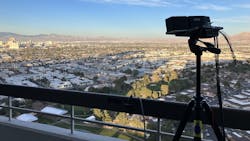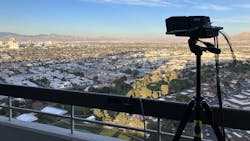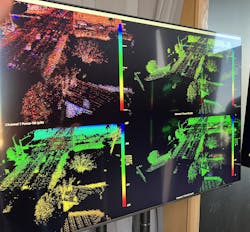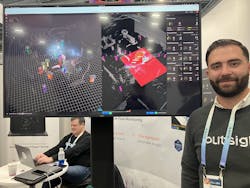This article originally appeared as part of the industry’s ONLY full CES show coverage in the February 2024 issue of Security Business magazine. Don’t forget to mention Security Business magazine on LinkedIn and @SecBusinessMag on Twitter if you share it.
LAS VEGAS – Until recently, radar used “pulsed” technology, meaning it determined the distance an object is from a sensor by calculating the timing difference of an emitted pulse and the received one. In recent years, radar solutions have largely transitioned to “continuous wave” (CW) technology, where radio energy is transmitted and then received from reflecting objects, which are then detected using the Doppler effect.
At CES 2024, SiLC Technologies Inc., showcased how it has applied Frequency Modulated Continuous Wave (FMCW) to LiDAR sensors, marking a potential evolution in the range, effectiveness and even affordability of the technology.
SiLC showcased its Eyeonic Vision Sensor technology, as well as the new Eyeonic Mini. Both feature a highly integrated FMCW LiDAR Silicon Photonics Chip that powers a LiDAR system with an impressive range of more than 2 kilometers. The level of integration is crucial for advanced warning and detailed environmental understanding, such as perimeter security and drone detection.
Ralf Muenster, VP of Business Development and Marketing for SiLC, demonstrated the device from the top floor of the Westgate Hotel in Las Vegas, producing a point cloud image for buildings that were more than 2,000 meters away from the sensor, which was perched on the suite’s balcony.
“Security customers looking to detect drones at a distance have shown a lot of interest in this,” Muenster says. “One of our customers, High Point Aerotechnologies, has tripods with multiple cameras, radars and jammers, and they want to add LiDAR to them. They can scan a large and wide field of view and can track a drone that is detected – they can even see the rotor blades of the drones spinning [with LiDAR].”
Muenster says FMCW technology will eventually bring the cost of LiDAR down. He recalled the first Velodyne units that used Time of Flight (ToF) technology going for $70K, where now those ToF LiDAR solutions are in the 3K range. He says FMCW’s major players – including Intel and Mobileye – will enable the costs to come down.
“We integrate these components at the chip level, and this is enabling the costs of LiDAR to come down tremendously with volume,” Muenster explains. “For auto manufacturers, the volume can be in the millions of units; for security applications, you have thousands, so there is a difference.”
Muenster adds they are working with several companies in the security field beyond drone and perimeter detection applications. He says there are organizations looking to use LiDAR for people monitoring in venues such as casinos, airports, and stadiums.
People Monitoring and Analytics
Another company at CES is aiming to revolutionize people monitoring using a combination of 3D AI software and LiDAR. France-based software company Outsight announced at the show that it has joined forces with PreAct Technologies, a specialist in LiDAR technology, to revolutionize Smart Infrastructure and People Flow Monitoring.
They say the partnership will make high-resolution LiDAR technology accessible at unprecedentedly affordable prices.
Combined with Outsight’s Spatial AI Software Platform, LiDAR can now be deployed on a large scale across various industries, targeted at applications requiring detailed spatial analysis and monitoring, such as smart cities, retail, transportation hubs, and in any other context requiring efficient people flow management in high-density areas.
“Outsight collects data using LiDAR sensors, and we have software that we’ve developed that allows us to extract the relevant data from the raw stream coming through the sensors,” explains Brandyn Ryan, a product specialist at Outsight who demoed the product for me. “It allows us to segment the relevant information and then build any sort of application on top of that…creating a very efficient method of data management.”
Ryan is quick to point out that they are not trying to replace video surveillance cameras in these industries; instead, they are hoping to work side-by-side with them. That said, he says the advantages of using LiDAR and 3D software vs. traditional video analytics include comprehensiveness of the data, but more importantly, anonymity of the data.
“We provide more robust information than cameras,” he says. “Yes, cameras can provide some of these metrics to a degree, but when you start talking about high-density areas where people are traveling far distances, [LiDAR] can provide that complete path with much higher accuracy. Also, since it is just a point cloud being captured, you are able to maintain a sense of privacy.”
Since Outsight is a software solution, it is LiDAR hardware agnostic. “We range from powerful high-end sensors to really small, low-cost sensors that are better suited for smaller retail spaces,” Ryan says. “We usually work with customers to help them figure out the best configuration to deliver the most optimized solution.”
Ryan adds that Outsight works with several VMS providers in the security space and already has a perimeter security plug-in for Genetec’s VMS.
Paul Rothman is Editor-in-Chief of Security Business magazine. Email him your comments and questions at [email protected]. Access the current issue, full archives and apply for a free subscription at www.securitybusinessmag.com.
About the Author
Paul Rothman
Editor-in-Chief/Security Business
Paul Rothman is Editor-in-Chief of Security Business magazine. Email him your comments and questions at [email protected]. Access the current issue, full archives and apply for a free subscription at www.securitybusinessmag.com.




